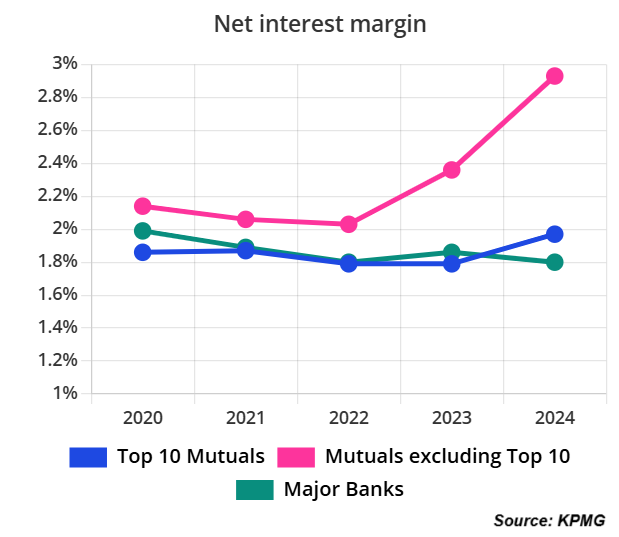Interest rate gains boost margins, but cost pressures and economic uncertainty weigh on profitability

Lending by Australia’s mutual banks, building societies, and credit unions – collectively called mutuals – rose by 7.88% to $139.6 billion during the 2024 financial year, according to KPMG’s latest Mutual Industry Review.
Deposits also grew by 5.11%, reaching $137.8 billion, despite ongoing economic pressures. However, operating profits for the sector remained flat, increasing by just 0.32% to $775.2 million. This follows a sharp 27% rise in profits last year.
The report highlights challenges tied to high interest rates and cost pressures, which have impacted overall profitability. Net interest margin improved by 45 basis points (bps) to 2.45%, reflecting the benefit of higher interest rates. But rising expenses pushed the sector’s cost-to-income ratio up by 292bps to 78.5%.
The mutuals’ capital adequacy ratio saw a slight increase to 17.71%, up from 17.6% in the prior year. According to KPMG, this positions the sector to invest in improving operational resilience and adapting to evolving regulatory requirements.

KPMG national sector leader Darren Ball (pictured above) noted that while inflation has eased significantly in the past year, the effects of economic uncertainty and cost-of-living pressures continue to weigh on households and businesses.
“The economic challenges of recent years show no sign of subsiding with continued softening economic conditions,” Ball said. “The mutuals must balance their community focus with the need to reduce costs, expand services, and protect members from growing cyber and financial crime threats.”
The KPMG report highlighted several key figures for the sector, including a 7.88% increase in lending to $139.6 billion and a 5.11% rise in deposits to $137.8 billion. Operating profit before tax edged up 0.32% to $775.2 million, while non-interest income fell by 2.02% to $310.7 million. Credit provisions increased to $187 million, and the sector completed four mergers over the year, up from two the previous year.
See LinkedIn post here.
The survey identified several priorities for mutuals over the next three years. Maintaining profitable and sustainable growth remains the top priority, with 91% of respondents selecting this as a focus area.
Key growth drivers cited include better product pricing, improved customer centricity, and enhanced service offerings. Digital transformation and market share growth were tied as the second most important priorities, with strategies for improving customer experience including reducing points of friction, automating workflows, and enhancing website functionality.
Mergers also remain on the radar for the sector. While 26% of respondents are actively considering a merger, fewer (17%) expect to be involved in one next year. Despite these strategies, the report noted a drop in overall optimism, with 60% of respondents expressing confidence in three-year growth prospects, compared to 73% last year.
Cybersecurity emerged as the top risk facing Mutuals, selected by 40% of respondents. Other concerns include funding challenges (26%) and compliance pressures (11%). Preparedness for cyber events has declined, with 76% of respondents considering themselves prepared, down from 81% last year.
“Mutuals that embrace technology to meet regulatory requirements, protect against cyber risks, and harness AI through better data management will position themselves for sustainable growth,” Ball said.
Want to be regularly updated with mortgage news and features? Get exclusive interviews, breaking news, and industry events in your inbox – subscribe to our FREE daily newsletter. You can also follow us on Facebook, X (formerly Twitter), and LinkedIn.



